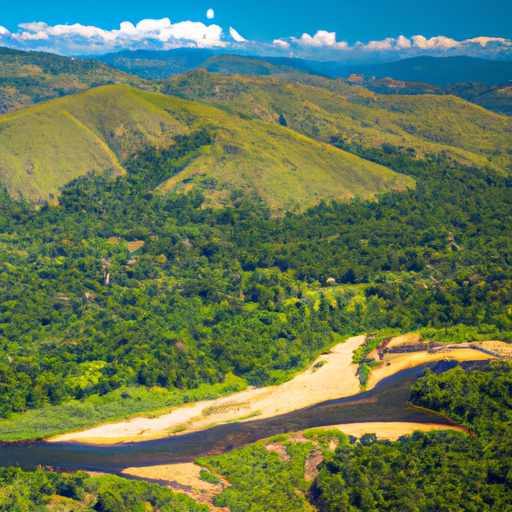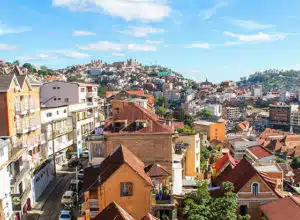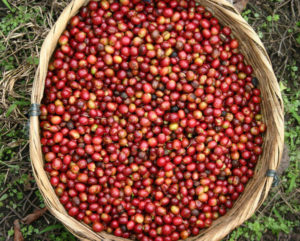Introduction to Madagascar’s unique biodiversity
General presentation of Madagascar
Madagascar, the fourth largest island in the world, is located in the Indian Ocean off the southeast coast of Africa. Known for its breathtaking landscapes and paradise beaches, this fascinating island is a true treasure of biodiversity. The geographic separation of Madagascar from the African continent approximately 88 million years ago allowed for the development of unique fauna and flora, making this island a living laboratory of evolution. By exploring the different ecosystems of Madagascar, you will discover an incomparable natural wealth, with an exceptional rate of endemism.
The biodiversity of Madagascar is not only impressive in its diversity, but also in its uniqueness. Approximately 90% of the plant and animal species found on the island are found nowhere else in the world. This singularity has attracted the attention of scientists, naturalists, and travelers from around the world, making Madagascar a top destination for nature and adventure enthusiasts. Preserving this biodiversity is essential for maintaining the island’s ecological balance and providing future generations with the opportunity to discover these natural treasures.
Importance of biodiversity on the island
The biodiversity of Madagascar plays a crucial role in maintaining local and global ecosystems. The island’s tropical forests, arid areas, and coral reefs are home to a multitude of species that interact in complex ways to create healthy and balanced environments. These ecosystems provide essential ecological services such as air and water purification, crop pollination, and climate regulation. The loss of biodiversity could have devastating consequences not only for Madagascar but also for the entire planet.
In addition, the biodiversity of Madagascar has significant cultural and economic value for local communities. Many plant and animal species are used in traditional medicine, crafts, and food. Ecotourism, based on the observation of the island’s unique flora and fauna, is an important source of income for the local residents. Protecting this biodiversity is therefore essential to support the livelihoods of local populations and promote sustainable development.
The diverse ecosystems of Madagascar
Rainforests
The rainforests of Madagascar are among the richest and most diverse ecosystems on the island. Located mainly on the east coast, these forests are characterized by dense and lush vegetation, housing a multitude of endemic species. Among the gems of these forests is the Masoala National Park, which is the largest national park in Madagascar. This park is a refuge for many rare species, such as the red ruffed lemur and the Madagascar serpent eagle. Visitors can explore these forests by following well-marked hiking trails, offering spectacular views of the canopy and waterfalls.
Tropical rainforests are also crucial for climate regulation and water conservation. They play a vital role in the water cycle by capturing and storing precipitation, which helps prevent flooding and droughts. In addition, these forests are important carbon sinks, absorbing carbon dioxide from the atmosphere and thus helping to mitigate climate change. Preserving these ecosystems is therefore essential not only for local biodiversity but also for overall environmental health.
Deserts and arid zones
In contrast to tropical rainforests, Madagascar is also home to deserts and arid zones that have equally fascinating biodiversity. The south of the island, in particular, is dominated by semi-arid landscapes and stunning rock formations. The Androy region, for example, is known for its unique spiny forests, where succulent plants and thorny trees adapted to dry conditions thrive. These ecosystems also harbor endemic animal species, such as the Madagascar day gecko and the flat-tailed gecko.
Madagascar’s arid zones also offer unique opportunities for eco-tourism and adventure. Visitors can explore spectacular landscapes through hiking, climbing, and trekking. Sites like Isalo National Park, with its deep canyons and natural pools, attract nature and adventure enthusiasts from around the world. Discovering these diverse ecosystems helps to better understand species adaptation to extreme environmental conditions and reinforces the importance of their conservation.
Endemic animal species
Madagascar’s lemurs
Among the most emblematic species of Madagascar, lemurs hold a special place. These endemic primates are found only on this island and include over 100 different species. Lemurs vary in size, behavior, and habitat, ranging from the tiny mouse lemur weighing only a few grams to the larger indri, known for its melodic songs. Lemurs play a crucial role in forest ecosystems as pollinators and seed dispersers, thus contributing to forest regeneration.
Lemurs are also a major attraction for visitors to Madagascar. Reserves such as Andasibe-Mantadia National Park and Anja Special Reserve offer unique opportunities to observe these fascinating creatures in their natural habitat. However, many lemur species are threatened by deforestation and illegal hunting. It is therefore essential to support conservation initiatives to protect these emblematic animals and their habitat.
Other Unique Mammals
In addition to lemurs, Madagascar is home to a variety of other endemic mammals that contribute to the richness of its biodiversity. Among them, the fossa, a fierce predator resembling a small puma, is one of the island’s best-known carnivores. The fossa is an agile hunter that primarily feeds on lemurs and other small animals. Its presence is essential for maintaining prey populations’ balance and the health of forest ecosystems.
Another notable mammal is the tenrec, a small insectivore that resembles a hedgehog. Tenrecs are incredibly diverse, with over 30 different species, each adapted to a specific habitat. They play an important role in controlling populations of harmful insects and contribute to soil fertility through digging. The protection of these unique mammals is crucial for preserving Madagascar’s biodiversity and the ecological functions they fulfill.
The botanical treasures of Madagascar
Endemic flora of the forests
Madagascar’s flora is equally remarkable as its fauna, with an exceptional rate of endemism. The island’s forests are home to a multitude of unique plants, including orchids, palm trees, and majestic trees like the baobab. The baobab, with its massive trunks and root-like branches, is one of the most recognizable symbols of Madagascar. These trees can live for several hundred years and play a crucial role in local ecosystems by providing shelter and food for numerous species.
Madagascar’s forests are also rich in medicinal plants used for centuries by local communities. Species such as ravintsara, known for its antiviral and antifungal properties, and katrafay, used to relieve muscular pain, are sustainably harvested for traditional medicine. The preservation of these endemic plants is essential for maintaining genetic diversity and the traditional knowledge associated with their use.
Medicinal and utilitarian plants
Madagascar is a real open-air botanical garden, where many plants have medicinal and utility properties. One of the most famous plants is the Madagascar periwinkle, whose alkaloids are used in the production of cancer drugs. This plant, once used in traditional medicine to treat various ailments, has attracted the attention of the scientific community for its therapeutic properties.
In addition to medicinal plants, Madagascar has a rich diversity of utility plants used in handicrafts and agriculture. Raffia, for example, is a natural fiber extracted from palm leaves and used to make handicrafts such as baskets, hats, and ropes. The preservation of these plants is essential to support the livelihoods of local communities and promote sustainable agricultural practices.
Conservation challenges
Threats to biodiversity
The biodiversity of Madagascar faces many threats that jeopardize its long-term survival. Deforestation, mainly due to slash-and-burn agriculture, is one of the main causes of habitat loss. Every year, thousands of hectares of forests are destroyed to make way for crops and pastures, thus reducing the available habitats for endemic species. This deforestation also leads to soil erosion, loss of biodiversity, and carbon emissions, further exacerbating climate change.
In addition, illegal hunting and the trade of wildlife pose serious threats to the fauna of Madagascar. Many species, including lemurs and tortoises, are captured and sold as pets or for their meat. These illegal activities endanger animal populations and disrupt local ecosystems. Combating these threats requires concerted efforts from local authorities, conservation organizations, and local communities.
Protection and preservation initiatives
Fortunately, many conservation initiatives are underway to protect the biodiversity of Madagascar. Local and international organizations are working collaboratively with local communities to implement effective conservation strategies. Reforestation, the creation of nature reserves, and the promotion of sustainable farming practices are some of the measures being implemented to restore habitats and protect endemic species.
Educational and awareness programs also play a crucial role in biodiversity protection. By informing local communities about the importance of conservation and involving them in protection projects, these initiatives contribute to creating a sense of shared responsibility. For example, community ecotourism projects provide economic incentives for nature preservation while allowing visitors to responsibly experience the natural richness of Madagascar.
The hidden natural treasures of Madagascar
Lesser-known biodiversity sites
Outside of well-known tourist sites, Madagascar has many hidden natural treasures that are worth exploring. The Tsingy de Bemaraha National Park, for example, is a UNESCO World Heritage site known for its spectacular karst formations and unique biodiversity. The Tsingy, with their sharp limestone peaks and deep canyons, are home to a multitude of endemic species adapted to this extreme environment. Visitors can explore this fascinating landscape through adventure tours that include suspended bridges and underground passages.
Another lesser-known but equally impressive site is the Massif of Makay, an isolated and unexplored region in southwestern Madagascar. This massif is made up of deep canyons, winding rivers, and dense forests, providing an ideal habitat for many endemic species. Expeditions in Makay allow for the discovery of pristine landscapes and the observation of unique fauna and flora. These little-known biodiversity sites offer exceptional opportunities for researchers and nature enthusiasts in search of discoveries.
Responsible Hiking and Eco-Tourism
For those who wish to explore Madagascar’s biodiversity responsibly, there are many options for hiking and eco-tourism. The island’s national parks and nature reserves offer well-marked hiking trails that allow visitors to discover local fauna and flora while minimizing their impact on the environment. Experienced local guides often accompany hikers, providing valuable information about ecosystems and encountered species.
Community eco-tourism initiatives also allow visitors to directly support conservation efforts. By staying in eco-lodges and participating in activities organized by local communities, travelers contribute to the protection of biodiversity while discovering the culture and traditions of Madagascar. Companies like Madagascar Trip’s & Pic’s offer tailor-made tours that include wildlife and flora explorations, cultural immersions, hiking, and adventure activities, providing a complete and responsible experience of the island’s natural beauty.
Conclusion
The unique biodiversity of Madagascar is an invaluable treasure that deserves to be discovered and preserved. From lush rainforests to arid deserts, from iconic lemurs to medicinal plants, every aspect of this biodiversity contributes to the ecological and cultural richness of the island. However, in the face of growing threats such as deforestation and illegal hunting, it is essential to support conservation initiatives and promote responsible tourism.
Madagascar Trip’s & Pic’s offers tailor-made tours for nature lovers, adventurers, cultural explorers, and families, allowing them to discover the natural and cultural treasures of Madagascar in a responsible manner. By choosing experiences like wildlife and flora explorations, cultural immersions, photography tours, and adventure activities, visitors can contribute to the protection of biodiversity while experiencing unforgettable moments. Together, we can help preserve the unique beauty of Madagascar for future generations.
FAQ
What makes the biodiversity of Madagascar unique?
Madagascar’s biodiversity is unique due to its exceptional endemic rate. Approximately 90% of plant and animal species found on the island are found nowhere else in the world. This singularity is due to the geographic isolation of the island for millions of years, which allowed for the development of distinct fauna and flora.
What endemic animals can be observed in Madagascar?
Madagascar is home to a variety of endemic animals, the most famous of which are lemurs. Around 100 species of lemurs, ranging from the small mouse lemur to the large indri, are present on the island. Other unique mammals include the fossa, a predator resembling a small cougar, and the tenrec, a diverse insectivore. Endemic reptiles, birds, and amphibians also contribute to the island’s faunal richness.
What are the main challenges for biodiversity conservation in Madagascar?
The main challenges for biodiversity conservation in Madagascar include deforestation, illegal hunting, and the trade of wildlife species. Deforestation, primarily due to slash-and-burn agriculture, reduces available habitats for endemic species. Illegal hunting and the trade of species endanger animal populations and disrupt local ecosystems.
Where can eco-tourism be done in Madagascar?
Madagascar offers numerous opportunities for eco-tourism, with national parks and nature reserves scattered throughout the island. Sites such as Masoala National Park, Andasibe-Mantadia National Park, and Isalo National Park are popular destinations for wildlife observation and hiking. Community eco-tourism initiatives also allow visitors to directly support conservation efforts while discovering the local culture.
What medicinal plants are found in Madagascar?
Madagascar has a rich diversity of medicinal plants used in traditional medicine. Among the most well-known are the Madagascar periwinkle, used in the production of cancer drugs. Other medicinal plants include ravintsara, known for its antiviral and antifungal properties, and katrafay, used to relieve muscle pain. These plants are sustainably harvested to preserve their future availability.








